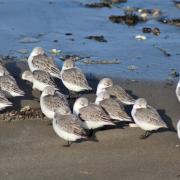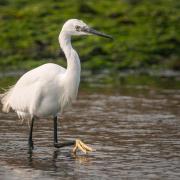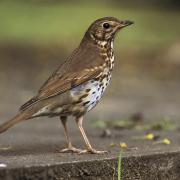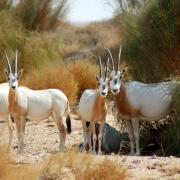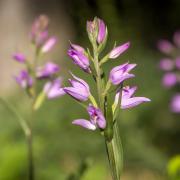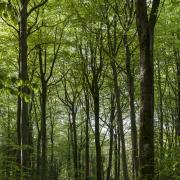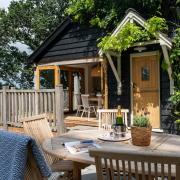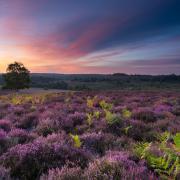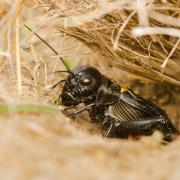Make it your New Years resolution to save the wildlife on your doorstep
Are you interested in local wildlife? Would you like to learn more about natural history? Did you know your local Wildlife Trust runs three specialist groups for people with a passion for amphibians and reptiles, mammals, and flora? The groups are supported by the Hampshire & Isle of Wight Wildlife Trust but organised by committees of dedicated volunteers who are experienced and extremely knowledgeable about local wildlife.
Hampshire Amphibian and Reptile Group (HARG) focus their efforts on conserving our local herpetofauna. There are 13 native species of amphibian and reptile, and 12 of them can be found in Hampshire. HARG organises many walks and talks, for example earlier this year, HARG members took a stroll around the Trust’s Nature Reserve, Hook Common and observed a pond full of croaking frogs and amorous toads, and witnessed a grass snake catching some afternoon sunshine. HARG also organises training days and have carried out a number of sessions for one of our most colourful, rarer and protected amphibians, the Great Crested Newt. Trainees learnt how to survey for newts using different techniques and how to tell Great Crested Newts apart from their cousins, the Smooth Newt and the Palmate Newt. HARG is chaired by John Poland, an ecologist and reptile and amphibian expert. John says, "everyone is welcome to come along to a HARG event, whatever their experience or ability". Look out for HARG events near you on the Trust’s website.
Hampshire Mammal Group (HMG) spend their time surveying and sharing knowledge about our mammal fauna. The variety of different habitats from wetlands and grasslands to woodlands means that Hampshire is home to important populations of some of the UK’s rarest mammals, including otters, dormice and water vole. HMG organise several interesting talks and walks for members to learn more about these species and in 2011 the Group held a fascinating talk on Shrews, carried out a Dormouse Nut Hunt, a Bat Walk and Badger Watch. HMG are also interested in how the different species are distributed in the county and carry out surveys in order to find out. For example, later this year the group will be carrying a number of small mammal survey sessions at Nature Reserves and Country Parks to find out how our voles, mice and shrews are faring.
Hampshire Flora Group are interested in all things botanical but also cover lichens and ferns. The Flora Group organise several events each month across the county, surveying and monitoring our local flora. Trips are often off the beaten track and cover a number of interesting sites. Last year, as part of the Trust’s 50th Anniversary celebrations, the Flora Group held a number of special walks, for example to Noar Hill, where members observed Pyramidal, Fragrant, Frog and Musk Orchids. The Group’s AGM was held at Mottisfont last summer, with a trip around the less visited parts, where they found Blunt-flowered Rush to be a prominent feature of the wet meadows, a plant not recorded in this part of the Test valley for nearly 30 years!
More information about all three groups and upcoming events can be found on the Wildlife Trust’s website under "get involved" at www.hwt.org.uk. Everyone is welcome to attend the events but if you would like to support the running of the groups by joining the Wildlife Trust, just follow the links to their membership pages.
News
At the start of 2011, the Wildlife Trust launched their 50th anniversary Living Landscapes Appeal seeking to raise �100,000 from members and supporters to help restore four local wildlife treasures as part of their Living Landscapes vision. Chris Packham kindly lent his support to the appeal explaining that, "Living Landscapes are all about seeing our nature reserves as the beating heart of the wider landscape in which they lie." With your support the Trust can help make nature:
• Bigger – by acquiring and restoring unique wet peatland at Alverstone Marshes.
• Better – by bringing neglected heathland back to life at Eversley.
• Joined-up – by restoring the condition of the historic water meadows outside Winchester.
• Inspiring to all – by creating a chain of wildlife rich habitats from the New Forest to the sea at Lymington.
Chris features on the Trust’s new video explaining the Living Landscape vision in Hampshire. You can watch this and see how you can get involved by visiting www.hwt.org.uk and following the Chris Packham appeal link. Alternatively, you can call 01489 774400 for more information.
Dates for the diary
Blow away the cobwebs
January 5, 10.30am Join staff at Swanwick Lakes Nature Reserve for a short walk looking for signs of life during the winter months. The perfect way to recover from the festive season! For further details contact Dawn Preston or Jess Daish-Miller on 01489 570240. Suggested donation �3 per person. Please wear outdoor clothing and sturdy shoes or boots.
Come in to roost
January 10, 3.30-4.30pm Meet Bob Chapman, Blashford Lakes Reserves Officer, in the Tern Hide to watch a dusk spectacle as up to 20,000 gulls, 500 geese and 200 goosander come in to roost on Ibsley Water. Meet at the Tern Hide car park, Blashford Lakes. To book contact Jim Day or Michelle Crooks on 01425 472760. Suggested donation �3 per person.
Help the heath
January 15, 10am-1pm Help the heath by joining Keith Blackmore cutting and burning invasive scrub on Yateley Common. Tools and instruction will be provided but please wear stout footwear. From the A30/B3272 roundabout take Bloomsbury Way and immediately turn right into Woodside. Meet at the small car park on the right. (Map ref. SU 843 592). For further details please contact Keith on 07770 918372. This event may be cancelled in the event of military training, so please call to check.
Hoary hedges and sleeping giants
January 29, 10.30am–12.30pm A gentle walk over Foxlease Meadows, identifying shrubs in an informal hedgerow survey. Meet at Foxlease Meadows off the A327 (Minley Road). Park at the Crown and Cushion Public House (Map ref. SU 835 571). For further details contact Keith Blackmore on 07770 918372. Dogs on leads and children are welcome. Please wear footwear suitable for muddy terrain. Suggested donation �1.50. This walk may be cancelled in the event of military training, so please call to check.
Wildline
Q. I would like to dig a pond in my garden but don’t know where to start!
A. A pond is an essential feature of any garden hoping to attract wildlife and can provide a refuge for many species of freshwater plants and animals including frogs, toads, newts, insects and birds. Size does not matter to water-loving creatures and they will find your pond within days whether it is an old sink or a properly-constructed freshwater habitat. Ponds can be dug at most times of the year but a pond started in spring will establish more quickly than at other times.
Try to site your pond in a sunny but sheltered spot. Avoid putting it near overhanging trees as leaves that fall in will rot and use up the oxygen in the water. Once you have chosen a suitable site, mark out the shape of your pond with string or canes. It will need to be at least 75cm to 1 metre deep at one point to prevent it freezing over completely in the winter. Incorporate gently sloping sides to allow animals to get in and out, plus shelves or ledges to provide variation in depth and provide a surface for pot plants.





